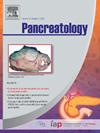多功能纳米平台系统的缺氧激活和放射增敏联合效应增强了胰腺癌化放疗的疗效。
IF 2.8
2区 医学
Q2 GASTROENTEROLOGY & HEPATOLOGY
引用次数: 0
摘要
背景:胰腺癌是一种恶性程度很高的肿瘤,目前仍是全球主要的健康问题。化疗和放疗是胰腺癌辅助治疗的常规方法,但其疗效有限:方法:在本研究中,纳米粒子(MSN-AuNPs)方法:本研究以替拉帕唑胺(TPZ)和透明质酸(HA)为药物载体,合成了一种多功能纳米平台HA@TPZ-MSN-AuNPs(HTMA),用于缺氧激活和放疗增敏,可与放疗联合使用,协同提高胰腺癌的治疗效果。体内和体外实验验证了该纳米平台的抗肿瘤性能:首先,成功合成了HA@TPZ-MSN-AuNPs(HTMA)。药物释放实验表明,酸性环境和透明质酸酶促进了纳米平台的药物释放。体外实验中,CCK-8、活死人染色、克隆形成实验和流式细胞术证实了 HTMA 具有缺氧激活和放疗增敏的联合抗肿瘤作用。在药物吸收实验中,纳米平台显示了靶向和结合胰腺癌细胞的功能。在体内,HTMA表现出良好的抗肿瘤特性和生物相容性:该纳米平台具有良好的靶向效果和协同抗肿瘤作用。结论:该纳米平台具有良好的靶向效果和协同抗肿瘤作用,将缺氧激活与放疗增敏相结合是一种治疗胰腺癌的有效策略。本文章由计算机程序翻译,如有差异,请以英文原文为准。
The combined effect of hypoxia activation and radiosensitization by a multifunctional nanoplatform system enhances the therapeutic efficacy of chemoradiotherapy in pancreatic cancer
Background
Pancreatic cancer is a highly malignant tumor, which is still a major global health problem. Chemotherapy and radiotherapy are regularly used in adjuvant therapy for pancreatic cancer but their therapeutic efficacy is limited.
Methods
In the present study, nanoparticle(MSN-AuNPs) was used as a drug carrier loaded with tirapazamine(TPZ) and hyaluronic acid (HA) to synthesize a multifunctional nanoplatform HA@TPZ-MSN-AuNPs (HTMA) for hypoxia activation and radiotherapy sensitization, which can be combined with radiotherapy therapy and synergistically enhance the therapeutic effect in pancreatic cancer. The anti-tumor performance of the nano platform was verified by in vivo and in vitro experiments.
Result
First, the HA@TPZ-MSN-AuNPs (HTMA) was successfully synthesized. Drug release experiments showed that acidic environment and hyaluronidase promoted drug release in the nanoplatform. In vitro experiments, CCK-8, live-dead staining, clonal formation assay and flow cytometry confirmed the combined anti-tumor effect of hypoxia activation and radiotherapy sensitization with HTMA. In the drug uptake experiment, the nanoplatform showed the function of targeting and binding pancreatic cancer cells. In vivo, HTMA demonstrated good antitumor properties and good biocompatibility.
Conclusions
The nanoplatform had a good targeting effect and synergistic anti-tumor effect. The combination of hypoxia activation and radiotherapy sensitization is a promising strategy for the treatment of pancreatic cancer.
求助全文
通过发布文献求助,成功后即可免费获取论文全文。
去求助
来源期刊

Pancreatology
医学-胃肠肝病学
CiteScore
7.20
自引率
5.60%
发文量
194
审稿时长
44 days
期刊介绍:
Pancreatology is the official journal of the International Association of Pancreatology (IAP), the European Pancreatic Club (EPC) and several national societies and study groups around the world. Dedicated to the understanding and treatment of exocrine as well as endocrine pancreatic disease, this multidisciplinary periodical publishes original basic, translational and clinical pancreatic research from a range of fields including gastroenterology, oncology, surgery, pharmacology, cellular and molecular biology as well as endocrinology, immunology and epidemiology. Readers can expect to gain new insights into pancreatic physiology and into the pathogenesis, diagnosis, therapeutic approaches and prognosis of pancreatic diseases. The journal features original articles, case reports, consensus guidelines and topical, cutting edge reviews, thus representing a source of valuable, novel information for clinical and basic researchers alike.
 求助内容:
求助内容: 应助结果提醒方式:
应助结果提醒方式:


